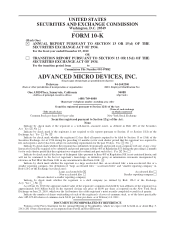AMD 2010 Annual Report Download - page 14
Download and view the complete annual report
Please find page 14 of the 2010 AMD annual report below. You can navigate through the pages in the report by either clicking on the pages listed below, or by using the keyword search tool below to find specific information within the annual report.Embedded Processor Products
Our embedded products address customer needs in PC-adjacent markets. Typically, our embedded products
are used in applications that require high to moderate levels of performance where key features include low cost,
mobility, low power and small form factor. High performance graphics are increasingly important in many
embedded systems. Customers of our embedded products include vendors in industrial controls, digital signage,
point of sale/self-service kiosks, medical imaging, set-top box and casino gaming machines as well as enterprise
class telecommunications, networking, security, storage systems and thin-clients, or computers that serve as an
access device on a network.
The embedded market has moved from developing proprietary, custom designs to leveraging the industry-
standard x86 instruction set architecture as a way to reduce costs and speed time to market. Customer
requirements for these systems include: very low power for small enclosures and 24x7 operation, support for
Linux, Windows and other operating systems, and high-performance for increasingly sophisticated applications.
Other requirements include advanced specifications for industrial temperatures, shock and vibration, and
reliability.
Our embedded platforms include options from the AMD Opteron, AMD Athlon, AMD Turion, and AMD
Sempron processor families; the AMD Embedded G-Series, which is the embedded version of our APUs; the
AMD Radeon™ graphics processor family; and numerous AMD chipsets. These products are part of the AMD
Longevity Program, which provides for an availability period of up to five years in some cases in order to
support lengthy development and qualification cycles and long-term life of the system in the market.
In April 2010, we announced two new complete platforms for the embedded market, the compact ASB2
platform and the high-performance AM3 platform with improved graphics performance and I/O features. Our
embedded platforms consist of chipset and graphics solutions along with high-performance CPUs. In January
2011, we launched the AMD Embedded G-Series platform. Based on AMD Fusion technology, the new G-Series
delivers a full-featured embedded platform and is designed to help reduce power consumption, physical footprint
of the components and the costs to design and produce highly-integrated embedded solutions.
Chipset Market and Products
Chipsets send data between the microprocessor and input, display and storage devices, such as the keyboard,
mouse, monitor, hard drive and CD or DVD drive. Chipsets perform essential logic functions, such as balancing
the performance of the system and removing bottlenecks. Chipsets also extend the graphics, audio, video and
other capabilities of computer systems. All desktop, notebook and server PCs incorporate a chipset. In many PCs,
the chipset is integrated with additional functions such as a GPU. An integrated chipset solution is commonly
known as an IGP (integrated graphics processor) chipset. Chipsets that do not integrate a graphics core will be
connected to what is known as a discrete GPU. IGP chipsets offer a lower cost solution and in some
circumstances can offer reduced power consumption or smaller system form factors. A majority of PCs make use
of IGP chipsets, while discrete GPUs are used in higher performance PCs and servers.
In November 2010, we began shipping the first of our AMD Fusion family of APU processor products. The
APU architecture replaces an IGP-type chipset with an AMD Fusion Controller Hub chip which performs the
input and output functions of the chipset. We believe that the combination of an APU and the AMD Fusion
Controller Hub will eventually replace our market for IGP chipsets. We expect that our portfolio of products will
continue to include discrete GPUs as we continue to introduce high performance CPUs in 2011.
6
























